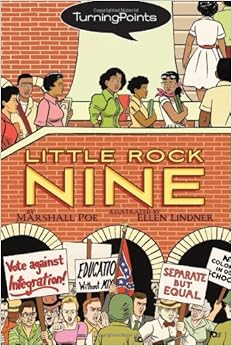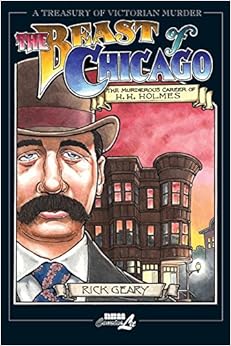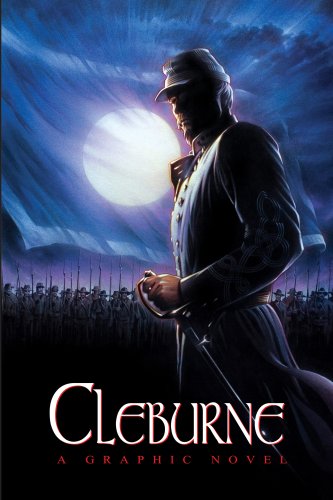
Opening Lines: May 17, 1954.
Engineer: Ready Charlie?
Charlie: Ready when you are.
Engineer: 3...2...1...we're live!
Charlie: In a landmark decision today, the Supreme Court ruled unanimously in favor of the plaintiffs in the matter of Brown versus the Topeka Board of Education.
Little Rock Nine tells the famous story of the nine students who were pioneers in integrating the Little Rock High School by looking closely at how that decision affected the people of that community. The book tells the story of Thomas, an African-American teenager who was hurt in an earlier attempt to integrate the schools, and whose family is opposed to him getting involved again. It is also the story of Will, a white teenager whose Dad is a lawyer who fought for integration of the schools,and whose grandpa is a traditionalist who opposes integration on allegedly moral grounds. Thomas and Will are on the same summer baseball team and Thomas's mother works as a maid in Will's house. As the arguments around integration of the high school become more heated, Thomas and Will find themselves in the middle of the arguments.
It seemed to me that the art in this book was a little odd, though I couldn't quite put my finger on exactly why. It might be that everyone's eyes seem a little too wide, or it may be that the facial expressions seem off to me somehow -- but these things do not detract from the story much. The story is on the one hand, nicely complicated, showing how often white and black families were torn as members within each family took up different positions on the issue of integration of the schools. At the same time, students older than middle school may find the story a bit simplistic.
The book does use the N word several times, mostly in the context of the students receiving training from the NAACP on not responding to violence. The word ass comes up a couple of times as well. It is hard to imagine an accurate portrayal of the anger of the times that wouldn't include these words, but some parents may find this objectionable
Geary, Rick (2003) The Beast of Chicago: The Murderous Career of H.H. Holmes. New York: Nantier Beall Minoustchine.

Opening Lines: The year is 1893. The world is coming to Chicago -- and Chicago is ready to meet the world.
Those who have read Erik Larsen's Devil in the White City are familiar with the story of H.H. Holmes, a drifter, fraud, confidence man, and above all, remarkably resourceful murderer. With the World's Fair coming to Chicago, Holmes established himself as a respectable man in the community and build an apothecary and rooming house in the Chicago neighborhood of Englewood. By using a revolving door of different contractors, Holmes was able to construct a building with secret passageways, trap doors, unventilated rooms, and hidden gas lines -- all to create a factory for murder.
Geary's graphic novel may not have quite the beautiful writing style of Larsen's book, but the images he uses, including building layouts, maps, and beautifully rendered line drawings (at times they look almost like woodblack prints) really help clarify the details of Holmes's story. That is not to say that the book is graphically horrifying. Thankfully, Geary leaves the more gristly bits up to the imagination.
This book would be an excellent companion piece to The Devil in the White City and could be a great way to bring students to that work. While not quite as transparent as Larsen's footnotes are, Geary does a nice job of describing his sources and clarifying what information is corroborated and which is speculation.
This graphic novels would be ideal for high school. Apart from the gristly subject matter, there is nothing particularly objectionable in the book.
McCloud, Scott (1998) The New Adventures of Abraham Lincoln. LaJolla: Homage Comics.


Opening lines: Monday! The sun downs on a mighty nation! Happy Commuters hurry to work! Eager bright-eyed children prepare for school! Here's the bus! Hop on board! Hurray for Monday in the good old U.S. of A.!
Okay, this one is pretty, um, odd -- sort of quirky. It is also a lot of fun. Scott McCloud, who most recently brought us the excellent graphic novel Sculptor, does a masterful job of telling this story (even though he choses to work entirely with computer-generated images, which frankly llook a little clunky sometimes).
Right, the story. So, high school student Byron Johnson and his friend Marcie are in detention after school (Marcie for having a bad attitude, and Byron for reading is class). Marcie asks "Who cares about American history" and a powerful superheroic character dressed in a stovepipe hat, bow ties and coat and tails bursts through the brick wall and takes them on a journey back in time riding on an american flag as if it were a magic carpet. It soon becomes apparent to Byron, however, that Lincoln is a liar and probably a fraud. He shows them Columbus claiming America with an American flag (despite the fact that Columbus never got any further north than the Dominican Republic), shows them the pilgrims arriving and immediately sitting down to picnic tables filled with thanksgiving dinner, and shows them Ben Franklin conducting electricity down a kite string to Thomas Edison who has just invented the lightbulb. Soon Marcie and Byron are travelling to Washington DC to stop the fake Lincoln. They are defeated and return home, where Byron encounters the real Abraham Lincoln. Together they defeat a plot by space aliens to enslave the American people.
I know, I know, it sounds ridiculous, and it is -- but i is also a remarkably witty exploration of the ways we use history to justify some rather silly arguments, of the errors in history that many people in the US have accepted as true, and ultimately, of why history matters. This would be a great book to introduce high school history students to some of the basic conflicts in history study (including bias--McCloud seems to take republicans to task more than democrats.) One of my favorite parts is when the fake Lincoln debates teh real one on live TV and wins easily due to his superior media savvy.
There is nothing particularly offensive in the book, though some Christian readers may object to repeated use of the phrase "Oh, My God!"
Murphy, Justin; Milgrim, Al; Brown, J. (2008) Cleburne: A Graphic Novel. Jacksonville: Rampart Press.

Opening lines: I can see the smoke on the horizon... I can smell the powder int he air... the dead are all around me... and the enemy approaches.
Patrick Cleburne was a general in the confederate army during the civil war. He is best known for arguing that the South should emancipate slaves and use them to solve its problem of dwindling army forces. Murphy's graphic novels dramatizes Cleburne's leadership as a general, his doomed relationship with Susan Tarleton, and eventually, his death in battle.
When I read it, I had the sense that General Cleburne was being built up into a perfect hero and I questioned whether he could have been that perfect. I found myself very suspicious of the facts as reported in the book. I wondered whether Cleburne really fought that hard to offer African Americans thier freedom and i questioned his motives. When I did some checking, I found that the story, though perhaps romanticized, is basically true. Eventually I realized that the fault may lie in Al Milgrom's inks. Milgrom cut his teeth inking superhero comics for Marvel. In his hands, Cleburne (as you can see int he cover image) cannot help but look heroic all the time. The art perhaps bends the story further than one realizes. Because of this, it might be good if using this in a middle school or high school class, to pair it with a more conventional biography.
In spite of its flaws, it is a nicely done biography that may pique students' interest.
Mehta, Rave (2012) The Inventor: The Story of Tesla. New York: Scholastic.

Opening lines: It is often said that Tesla was born of lightning and put on the earth to lead man into our next evolution... into our next revolution.
Read the opening lines. Really? It is often said? By whom? That line pretty well typifies the voice of this graphic novel -- overdramatic and somewhat full of itself. At the end of the publication data it says "The characters and events depicted here are based on true events, but we've taken some creative liberties, so enjoy it for what it is, a great story!" From the start then, we know that, although it might be a great story, the historical facts of this book will be suspect.
And so what we get is a remarkably one-sided depiction as a genius whose attempt to better mankind was thwarted again and again by the selfish and possibly evil Thomas Alva Edison. Tesla does all the work and Edison takes and the glory, and makes fun of Tesla's Alternating Current in the bargain. The story is sometimes coherent and entertaining (for example the part where Tesla demonstrates alternating current for Mark Twain). There is not much science here, and not much history either. Spelling errors and a lack of knowledge of graphic novel conventions (like bracketing translations of foreign languages so the readers know that the characters are not speaking English) make what is not a bad story into a pretty wretched graphic novel.
I would take a pass on this one if I were you.
No comments:
Post a Comment